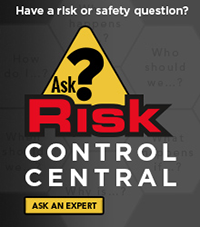Risk Alerts for Camps and Conference Centers
Practice safe climbing wall techniques
When it comes to climbing wall injuries, the most common are foot and ankle fractures, sprains or strains. Although climbers are strapped into harnesses, they can still miss a rock and fall to a safety mat, landing feet first and injuring their foot or ankle.
In order to help you prevent these types of injuries, we have included three lists of best practices regarding wall-building considerations, everyday safety and rules for climbing wall use. Although these checklists are a good starting point, they should not be considered as an all-inclusive climbing wall safety plan.
Design wisely to lessen chance of injuries
The first step to help ensure climbers’ safety is using appropriate precautions when designing the wall and having it installed. Listed below are tips to help you begin the process.
- Analyze wall angles to determine areas where a climber may fall and make sure proper padding is positioned in those places. Vertical walls need about six to eight feet of clear landing space, whereas steep walls require at least 13 feet of landing area, based on the overhang that protrudes the furthest.
- Determine landing material based on location of the wall (i.e., indoor vs. outdoor, foam vs. pea gravel).
- Ensure that rocks are comfortable to grip and tendon-friendly.
- Enclose wall with a barrier and lockable entrance to prevent after-hours climbing. If you have moveable walls, make sure there is a safe place allotted for wall storage.
- Be aware of the climbing wall’s weight limit as it pertains to the climbers who will be using it.
- Contact a professional climbing wall installer to review your needs and find out which type of wall is ideal for your facility.
Safe practices for everyday climbing wall use
It might seem like common sense, but just by following climbing guidelines and stressing the importance of safety procedures to all staff and climbers, you can prevent many accidents.
- Require every climber to participate in a short training session before using the wall. Training should include basic skill requirements that determine climbers’ skill levels, review of the belay commands, and general climbing safety. Training should conclude with a test that all climbers must pass before they are allowed to use the wall.
- Don’t allow climbers to use their personally owned climbing equipment (except climbing shoes). Provide equipment for all climbers and check that it is working properly each time before it is used.
- Control access to the wall during open and closed times. The wall must be supervised by an adequate number of adult staff at all times.
- Require staff members who assist climbers to complete annual wall-climbing safety training.
- Post rules for appropriate use of the wall and require everyone to sign a waiver form before climbing.
- Stay up to date on climbing equipment alerts to make sure your equipment is not subject to any
- safety-related recalls.
- Periodically check the climbing wall for any loose rocks or cracks. Repair any defects before climbers are allowed to use the wall.
- Encourage climbers to warm up before using the wall by stretching. Consider posting a sign to show different stretching exercises.
- Limit climbing wall capacity according to the number of walls and their weight limits.
- Prohibit bouldering (climbing at heights less than 10 feet) below other climbers.
Rules for climbing wall use are crucial
Before climbers are allowed to use the wall, make sure they are informed of and understand all safety rules. Some rules to include:
- Trained adult supervisors must be present at all times — even for skilled climbers.
- Supervisors must be at least 16 years old and must pass a belay certification course. Minors should not belay climbers who are their own age. Training courses are available through various trade organizations such as the Professional Climbing Instructors Association: http://www.pcia.us/programs.
- Children must be at least 10 years old to use the climbing wall. All minors must have a waiver and consent form signed by their parent or guardian.
- All climbers must wear helmets and slip-resistant shoes.
- Climbers must be visually inspected by a supervisor before climbing to make sure their safety belt is worn correctly.
- Loose rocks should be reported to a supervisor immediately.
- Proper belay and climbing commands should be used with every climber ( i.e., “On Belay,” “Belay On,” “Climb On” and “Climbing”).
- No food or drink allowed near the climbing area.
- Climbers must remove or cover any jewelry with tape.
Remember that safety rules must be followed and strictly enforced, and supervisors should always be on the lookout for situations that could create safety hazards.
For a complete collection of the Risk Alert for Camps & Conference Centers series, click here.







